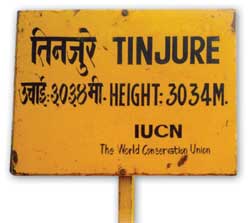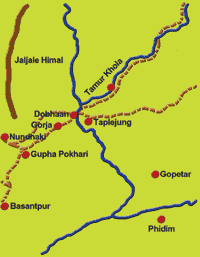 It may not rank among the natural world's most celebrated events like the monarch butterfly passage, phytoplankton blooms, wildebeest migration, or the New England fall colours. But the annual flowering of the rhododendron in Nepal is well worth travelling to see.
It may not rank among the natural world's most celebrated events like the monarch butterfly passage, phytoplankton blooms, wildebeest migration, or the New England fall colours. But the annual flowering of the rhododendron in Nepal is well worth travelling to see.
And the place to see it is the Tinjure Milke Jaljale (TMJ) ridge in eastern Nepal. In the coming weeks these scenic hills will be awash with red-not of political fervour but of rhododendrons in full bloom. The junction of three districts in the northeastern hills-Taplejung, Sankhuwa-sabha and Tehrathum-is home to Nepal's prime rhododendron forests and a natural niche for several rhododendron species. This is nature's display case for our national flower.  If the regular in mid-hill topography is north and east-west ranging hills cut by longitudinal valleys, the TMJ ridge is different. It ranges north in one long stretch and extends from Dhankuta to Basantapur and all the way to the Jaljala and Lumba Sumba Himal and Tibet. The run-off from the eastern flank joins the Tamur river system, from its western flank, the Arun. The ridge is a recently peopled frontier, as the mixed nature of the larger settlements will tell. The more recent arrivals followed the roads into the area and the opportunities that came with it-portering, inn keeping and petty trade. The largest ethnic group here are the Kirat, predominantly Limbu, for whom this area is historically home, followed by Bahun-Chhetri, Gurung, Magar, the Sherpa who came in from the north, and other groups.
If the regular in mid-hill topography is north and east-west ranging hills cut by longitudinal valleys, the TMJ ridge is different. It ranges north in one long stretch and extends from Dhankuta to Basantapur and all the way to the Jaljala and Lumba Sumba Himal and Tibet. The run-off from the eastern flank joins the Tamur river system, from its western flank, the Arun. The ridge is a recently peopled frontier, as the mixed nature of the larger settlements will tell. The more recent arrivals followed the roads into the area and the opportunities that came with it-portering, inn keeping and petty trade. The largest ethnic group here are the Kirat, predominantly Limbu, for whom this area is historically home, followed by Bahun-Chhetri, Gurung, Magar, the Sherpa who came in from the north, and other groups.
The rhodo-trail stretches from Basantapur to Sabhapokhari via Tute Deurali, Panchpokhari, Tinjure Deurali, Chauki, Mangalbare, Lampokhari, Guphapokhari and Sabhapokhari. There are buses that run from Dharan to Basantapur, or, if a fairly large group, you can hire one of several Land Rovers, relics from the Dharan British Camp days, that come fairly steep. Basantapur is a friendly town, sleepy and oddly reminiscent of Asterix's village in the comic book series. Everything revolves around the hearth. The gracious hospitality, large amounts of tongba and generous servings of red meat adds to the warmth. Food and accommoda-tion are considerably cheaper than saturated trekking routes so you can hold off the bargaining and concentrate on the view.
East Nepal is exciting even minus the flora-less explored, great ethnic diversity and wildlife, magnificent views of the eastern Himalaya and lots of adventure options for rafting and mount-aineering. You can fly to Tumling-tar from Kathmandu, or to Taplejung from Biratnagar, or 4WD to Basantpur from Dharan or Gopetar from Phidim Depart Basantapur along the dirt track that leads to Chouki, past Tute Deurali and its oak-rhododendron forests to Panchpokhari. Midway on this stretch is the Pathivara temple, a replica of the main temple of Taplejung, where you can have your first awe-inspiring view of the eastern Himalaya and good views of Basantapur and all that you left behind. Onward, just before Panchpokhari, is the Tinjure hilltop, ideal for camping because the ridge offers very few other flat places to pitch tents. The top is the highest point on the Tinjure stretch and is reputed to offer a view of 12 districts on a fine day. Higher on the horizon soars the Everest, Makalu and Kanchanjunga ranges, up close and awe inspiring.
 Chouki is like a "Visit Nepal" poster: it is surrounded by rhododendron trees, the people are friendly and you can get clean, good food, comfortable beds and spectacular views of the eastern Himalaya. Onward from Chauki to Guphapokhari the road leads to Mangalbare, a small hamlet of some 25 homes, which also offers fairly decent lodgings. From the sacred lake are some of the best views of the Everest, Makalu and Kanchanjunga ranges that the ridge can offer. If you have enough time go to Mench-hemdhap, the highest point on this stretch that also offers a 12 district view on a fine day. From here, take the trail to Sabhapokhari.
Chouki is like a "Visit Nepal" poster: it is surrounded by rhododendron trees, the people are friendly and you can get clean, good food, comfortable beds and spectacular views of the eastern Himalaya. Onward from Chauki to Guphapokhari the road leads to Mangalbare, a small hamlet of some 25 homes, which also offers fairly decent lodgings. From the sacred lake are some of the best views of the Everest, Makalu and Kanchanjunga ranges that the ridge can offer. If you have enough time go to Mench-hemdhap, the highest point on this stretch that also offers a 12 district view on a fine day. From here, take the trail to Sabhapokhari.
The TMJ ridge is spectacular eco-tourism country, and is quite strategically located for nature tourists between two protected areas. This is still arcadia, no pasta on the menu, no curio shops, no tiger balm, and no touts. The rhododendron trek can be done even by the moderately fit. Basantapur to Guphapokhari is all within 2000-3000m. Typically, very little money that accrues from eco-tourism goes to communities. TMJ is only getting started, and with the ceasefire this could be the spring of hope for the east.
 Off the rhodo trek
Off the rhodo trek
. Depart from the main trail at Guphapokhari toward Taplejung Pathivara via Gorja, Change and Dobhan.
. Take the trail from Dobhan to Olangchung Gola (trail leads all the way to Tibet).
. Visit Hyatrung falls, reportedly the largest in Asia, which can be reached via Guphapokhari, Srijung and Pauthak.
. Guphapokhari to Srijung, Morahang, Jirikhimti, Myanglung and Lahsune before returning to Basantpur (considered a culture trek).
. Guphapokhari to Makalu Barun base camp via Nundhaki and Khandbari of Chainpur. The latter can also be reached via Mude Sanischare.
 . Tread easy, manage your impact.
. Tread easy, manage your impact. . People depend on rhododendron forests for fuelwood. If you have porters or engage the services of a mule, carry kerosene stoves and fuel.
. Do not litter. Carry non-degradable waste back. Even Basantapur has no facilities for recycling.
. Bury human waste, at least 30m from any water source.
 . Carry some drinking water supplies. The ridge has its limitations.
. Carry some drinking water supplies. The ridge has its limitations. . Spread tourism money around. Purchase goods and services from little people.
. Yak caravans: step aside and let them pass, especially on narrow trails.
. Hailstorm: take shelter, hailstone size matters.



